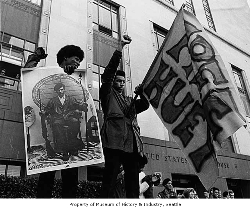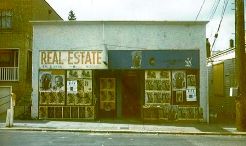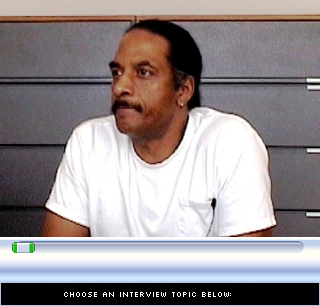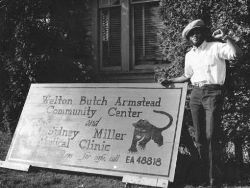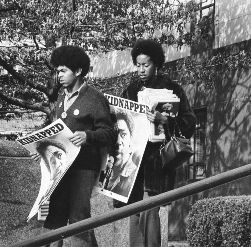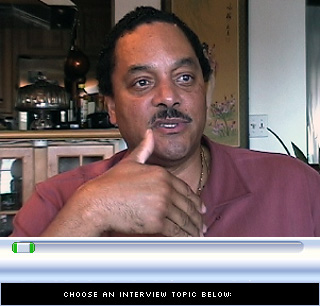This article explores the first three years of the Seattle chapter of the Black Panther Party from its founding by Black Student Union members in 1968 through the 1970 crisis negotiated by Mayor Wes Uhlman. The essay is presented in three parts:
Part 1: Background--the BSU and Black Power
Part 3: The Panthers and the Politicians
Background--the BSU and Black Power
The American civil rights movement has benefited from the contributions of various individuals and organizations that have employed a variety of strategies. In the early and mid 1960s under the leadership of Dr. Martin Luther King, Jr. the movement achieved breakthrough victories using non-violent civil disobedience. Yet while his strategies brought some successes, King experienced his share of frustrations. These setbacks and other historical realities encouraged some African Americans to pursue alternative methods. One product of that search for alternatives was the Black Panther Party, a chapter of which was founded in Seattle in 1968.
Seattle shared a number of similarities with the nation’s other northern and western metropolitan centers with regard to race relations. ThoughSeattle’s black population had been quite small for much of its history, during World War II it grew by 413% as blacks came west to work in the region's defense industries.1Prior to the war,Seattleblacks had been more or less forced to live in what was known as the city’s Central Area.That trend continued both during and after the war.2Hence, just like in other cities, blacks were socially quarantined into a small district of the city, a neighborhood that offered limited housing opportunities and second rate facilities and infrastructure.
Though Seattle’s black population had been historically small, the city had been no stranger to racial problems Generally speaking African Americans were never denied their right to vote or demonstrate, nor were they ever the victims of systematic violence. However, they were constantly confronted with hiring discrimination and housing restrictions, along with some instances of police brutality. Many of Seattle’s blacks fought back in one form or another, some by participating in civil rights and self defense organizations including the NAACP, the National Urban League, the Universal Negro Improvement Association, the Congress of Racial Equality, and the National Negro Congress, the Nation of Islam, the Student Nonviolent Coordinating Committee, and the Black Panther Party.
The Black Panther Party became known as one of the most radical and violent of the black civil rights organizations. In some cases, this persona was justified. The group existed in numerous cities across the nation and during its initial years each chapter promoted armed militancy as its primary tenet. Shootouts between Panthers and police bear witness to the seriousness of the Panthers’ pledge. That a chapter would emerge in Seattle, a place where racism existed, but was perhaps less severe than in other American cities, might seem surprising. But the fact that the chapter did form there reveals the complexities of the civil rights movement. The Party’s existence in Seattle shows that racism does not have to be violent to be intolerable. At the same time, the Seattle BPP revealed that a group that is willing to resort to violence is not predestined to always employ that strategy in order to meet its aims.
One final point worth considering is that most cities that had a BPP chapter had politicians who exhibited a strong urge to confront and destroy the organization. Raids on BPP offices in Chicago , New York , Hartford , Los Angeles and Philadelphia are some of the more notable examples of this activity. Seattle , however, was different. As stated earlier, though racism in Seattle was real, it could still be described as muted. The existence of a tempered racism created an opportunity for some state and local leaders to take actions and make statements that could certainly be termed tolerant, if not conciliatory, toward the Party. These actions can be understood as just one more example of the independence that has predominated in Northwest politics for quite some time.3
BEGINNINGS
The Seattle chapter of the Black Panther Party was formed out a sense of anger and frustration. Blacks in that city, as well as across the nation, had heard many promises with regard to the attainment of racial equality. However, time and time again, the promises were only partially kept, or simply forgotten. Consequently some Seattle blacks felt that they had invested enough patience and hope into the government and available civil rights institutions. A handful of Seattle blacks concluded that the platform of the newly formed Black Panther Party offered a more affective method of securing the fruits of racial equality. The presence of the BPP in Seattle raised the civil rights debate in the city to a new plane. This debate revealed both a heightened black consciousness as well as a countervailing white concern about what steps blacks might take to project and protect that consciousness.
This story begins with the Dixon family who came to Seattle’s Central Area from Chicago in 1958. They joined many other blacks who immigrated to Puget Sound for economic opportunity.4 The family’s children were told of their great great-grandmother’s experience as a slave as well as their parents’ subsequent experiences with racism. Aaron and Elmer Dixon were the two oldest sons in this family and they were molded by their parents’ stories. They recall being active in protest at an early age when they marched with Martin Luther King during his visit to Seattle in 1961.5 As the two boys grew to adulthood in Seattle, both had their own experiences that would influence their understandings of race and racism.6
Aaron, who is one year older than Elmer, learned of racism’s cruelties first hand when he became one of the first students in Seattle to be involved with the city’s voluntary school integration program. He eventually attended the predominantly white Queen Anne High School. While there Aaron said he experienced a subtle form of racism. He received unusually poor grades and he said he noticed that the teachers did not treat him or the other black students the same as his white classmates. Meanwhile, he often was the target of racially derogatory remarks. Racism came in other forms as well. Aaron recalled participating on a Seattle Parks Department tennis team that competed for the city championship. His teammates were all Black players save for one white Jewish player. They played an all-white team for the city title at the Lake Washington Tennis Club, a venue that had a segregationist policy. The prize for the winning team was lunch at the club and time in the facility’s swimming pool. Aaron’s team won. This represented a challenge to the tennis club’s policy, but the club did not back down. Ultimately only the Jewish player was allowed inside to enjoy his lunch, while Dixon and the other Black players had to eat hot dogs outside in the parking lot. None of the winners were able to enjoy the pool.7
Elmer Dixon’s early experience with race was different. He said that up until the age of seventeen he “was not consumed with race.” Elmer noted that his family lived in the Madrona neighborhood, a predominantly African-American community that was also home to numerous other races. “My friends were a full reflection of the rainbow. I had friends that were Chinese, Japanese, Latino, and white.” But Elmer recalled racism’s affects. “My mom was denied a job because she was black. She called up on the telephone at one place and they told her that she could have the job when she got down there. When they saw that she was black, they told her they did not have any jobs left.”8
These two anecdotes represent just some of the indignities that blacks faced while growing up in Seattle. Incidents like these compelled Aaron and Elmer Dixon to search for a way to effectively react to the treatment they received. Of the options that were available, the Dixons would eventually conclude that the Black Power movement offered the best promise.
The term “Black Power” has been traced to a speech given in 1965 by then New York Congressman Adam Clayton Powell, Jr.9 The actual ideology behind the term came well before that, as its ideals can be seen in the movement of Marcus Garvey and the Harlem Renaissance of the early 20th Century. The Black Muslim movement, which began in the 1930s, also promoted the philosophy of racial solidarity and pride. But it was not until the 1960s that Black Power gained broader acceptance in black America when Stokely Carmichael, the leader of the Student Nonviolent Coordinating Committee (SNCC) co-opted James Meredith’s attempted Freedom March through the state of Mississippi in 1966. Then in 1967, Carmichael published Black Power: The Politics of Liberation in America, a manifesto that called for Blacks in America to embrace a new attitude and strategy regarding civil rights. He wrote,
[Black Power] is a call for black people in this country to unite, to recognize their heritage, to build a sense of community. It is a call for black people to begin to define their own goals, to lead their own organizations, and to support those organizations. It is a call to reject the racist institutions and values of this society.10
Carmichael’s belief was that in order for blacks to gain equality, they had to create strength and unity among themselves. Once that was accomplished they would then be able to negotiate with whites from a position of strength rather than dependency.11 The Black Power movement of the 1960s gained a wide following in short order.12
Black Power’s arrival in Seattle did not occur on one particular day. But the theory certainly became much more relevant within the city after Stokely Carmichael delivered a set of speeches there on April 19, 1967. During his visit, Carmichael addressed an audience of around 4,000 listeners at the University of Washington. He then spoke to another 6,500 people at Garfield High School later that afternoon. Carmichael reiterated the themes of his book by criticizing whites for their role in denying Blacks their freedom. He said it was time for Blacks to experience a “new day” as well as strike back for the “church bombings, the cattle prodding and shooting of our homes.” He discussed Black Power, defining it as a “coming together of black people to fight for their liberation by any means necessary.” He explained that he preferred to use the word “Black” as opposed to “Negro” when talking of African Americans because, “We are Black and we are beautiful.” According to a reporter, the predominantly black listeners of various ages were enthralled with the message.13
Aaron and Elmer Dixon were in the Garfield High audience. Though they heard the same words, they initially left the speech with different conclusions. Almost four decades later, Aaron Dixon recalled Carmichael’s speech as being a turning point in his life. “For the first time I heard a black person speaking very defiantly against white Americans and racism…It was very powerful and very electrifying and it totally changed me.” Dixon noted that Carmichael’s speech prepared him to take a more active and militant approach to civil rights. “I think that the interpretation that I had was that it was a new day, that no longer would we sit idly by and be beaten up, or let racist incidents happen without some kind of repercussions. If we had to burn the whole city down, that’s what we would do.”14 Elmer, who was sixteen years old at the time, was not equally affected. “I didn’t know who this guy was. I remember walking away from there thinking, oh, that’s B.S. It doesn’t matter what the color of your skin is or what clothes you wear. My best friends were white…” But Elmer said after a period of contemplation, he developed a different understanding of what Carmichael was trying to say. He began to see validity in Carmichael’s argument that the term “Black” had been consistently attributed with qualities of evil and negativity. Also, he realized that Carmichael was not attacking his white friends as racist, but rather targeting the institutionalization of racism and its perpetuation of inequity in the black community.15
Many blacks in Seattle interpreted Carmichael’s Black Power message as a call to action. But their interpretations of how Black Power should be employed were not always in complete unison. The Dixons were to pursue one strategy. The experiences of Larry Gossett can serve as an example of another option.
Larry Gossett grew up in Seattle and though he was occasionally the target of racial indignities, he, like Elmer Dixon remained somewhat passive concerning racial issues. However, midway through his college career at the University of Washington Gossett joined the VISTA program, and he was assigned to Central Harlem. It was there that Gossett said he was confronted with realities that were both “shocking and enlightening.” What shocked Gossett the most was the intense poverty and the “compressed humanity”, as people were crammed into rat-infested, run-down, and squalid apartments. In Gossett’s mind this was the epitome of racial oppression.16 Though Gossett was in Harlem when Stokely Carmichael spoke in Seattle, he did hear Carmichael’s cohort, H. Rap Brown, speak in New York. Gossett said he likewise became exposed to the ideas of Malcolm X, who had established his headquarters in Harlem after his split with the Nation of Islam. Gossett said that these experiences revealed to him the possibilities of Black Power. Gossett recalled, “When I went into VISTA I was a Negro capitalist. When I came out I was a Black Revolutionary Socialist.17
BLACK STUDENT UNION
In September of 1967, Gossett returned from Harlem to the University of Washington and joined the local SNCC chapter. It was through this organization that he first met Aaron Dixon, a University of Washington freshman, and his brother Elmer. During the Thanksgiving weekend that fall, they, along with several other black university students, traveled to Los Angeles for a Black Youth Conference where the students were introduced to representatives of Black Power groups that included the Black Student Union (BSU), the United Slaves (US), and the Black Panther Party (BPP). Upon their return to Seattle, Gossett decided to establish a BSU chapter at the University of Washington. Gossett was elected to lead the organization and soon he and his cohorts, who included Aaron and high school student Elmer Dixon, began an effort to start BSU chapters at high schools and middle schools across Seattle.18
As head of the University of Washington BSU Gossett became one of several prominent spokesmen for Black Power in Seattle. In a Seattle Post-Intelligencer article he stated, “I believe that black people must be obsessed with thinking black. Then they will understand the need for determining their own destiny.” He added that blacks should have the same amount of power that reflects their numbers in the community. “If there are thirty-percent black people they should be represented by thirty-percent of the decision-makers.” In a statement that echoed the words of Carmichael as well as a portent of an increasingly defiant voice emanating from Seattle’s black community, Gossett stated that Black Power meant, ”self determination, self-respect and self defense, by any means necessary.”19
Michael Ross of the Seattle Legal Services Program was also interviewed for the article, and while he shared Gossett’s overall theory of Black Power, he represented yet another opinion on where it should be focused. Ross believed that the Black Power should speak primarily to the city’s poor. He criticized Blacks “that have been homogenized by the university and who now serve as spokesmen and leaders for the black community because whites feel at ease with them.” He said they were not the ones who could develop Black Power in its truest sense. He continued that Black Power would only be legitimate when Black leaders come forth who communicate in the way and manner of the people who sit in the ghetto porches and hang out on the ghetto street corners. For Ross, Black Power leadership should arise from the carpenters, welfare recipients, and unemployed.20
Ross’ comments were reminiscent of previous debates regarding the idea of whether revolution should be led from the top or the bottom. His statements also revealed that Black Power could be understood in different contexts. His ideas were indicative of a militant philosophy that was already being applied in the West Coast port city of Oakland. It would eventually be incorporated into the Central Area of Seattle, through the efforts of Aaron and Elmer Dixon.
As Seattle’s Black Power advocates debated methodology, they put their beliefs into practice. One of the first issues they tackled was educational integration. On March 6, 1968, the Central Area Civil Rights Council (CACRC) announced plans to close five schools in the Central Area. It was the hope of the CACRC that these closures would force black students into white schools where, they believed, better educational opportunities existed. The Seattle Area Black Student Unions (SABSU) joined other organizations in criticizing the plan arguing that the CACRC did not understand the needs or feelings of the Central Area’s lower class residents. In line with Black Power’s call for keeping black students together rather than dispersing them to other institutions, the SABSU argued that the schools needed to be fixed, not abandoned. The CACRC ultimately backed down from their plan.21
After successfully halting the CACRC’s plan, the BSU became active in further protests. One demonstration became Seattle Black Power’s symbolic Lexington and Concord. On March 29, 1968, Larry Gossett, Aaron Dixon, and Carl Miller, a fellow BSU member, led over 100 students in a sit-in at Franklin High School. The protest was a complaint against the suspension of two black students. The protestors called for more black history courses and the right to wear Afro hairstyles. Police were called to the scene and they warned the protestors that, if necessary, they would enter the school and physically remove them. The students dispersed but Gossett, Dixon, Miller, and another Franklin High School student were all arrested.22
The bond hearing for the men was set for April 4, 1968. During the hearing, bail was announced and Dixon, Gossett, and Miller were all led away for detainment until the bond could be posted. As the hearing was taking place, Elmer Dixon, who was involved in the Franklin High School incident but was not arrested, sat in his high school geometry class at Garfield . He recalled that his teacher walked up to him and told him he was wanted in the office. “…As soon as I stepped out of the classroom there were two detectives there who put handcuffs on me and told me I was under arrest for unlawful assembly, and they took me to juvenile.”23 As the four young men were being detained that afternoon, they all learned that Martin Luther King, Jr. had been assassinated. Aaron Dixon said when he received the news he was sitting in a dark, dingy King County jail. The fact that he got the news of King’s death while in that predicament served to harden him. Aaron believed that King had had worthy ideas, but that over time his stance seemed overly compliant and too static. Nevertheless Dixon said he respected what King was trying to do and his death only seemed to justify his frustration with American society. “When King was killed there was an uprising throughout…all of black America. I know I said at that point…it’s time to turn to more violent ways of doing things because they killed a man of peace through violence. We have no other alternative but to turn towards violence.”24
The detainment of the Dixons and Larry Gossett is yet a further example of how and why Black Power, and eventually the Black Panther Party, could take root in Seattle. Though Seattle did not experience the same level of racial confrontations that numerous other cities did, it was obviously still a place where a black man could end up in jail for making a statement of conscience. All three men were educated, middle-class, African Americans who were feeling that frustration. It was a frustration that would compel the Dixons to move beyond the possibilities of the Black Student Union.
FUNERAL IN OAKLAND
Soon after their release from jail, Gossett and the Dixon brothers joined a contingent of fellow BSU members for a trip to San Francisco to attend a BSU conference at San Francisco State University. While there they met BPP co-founder Bobby Seale. He told them that the Party was holding a funeral for its first recruit, seventeen-year-old Bobby Hutton, who had been killed in a shoot-out with Oakland police on April 6, just two days after the death of Reverend King. The funeral was to forever change the way some members of the Seattle contingent viewed the definition of militancy.25
The Seattle contingent’s attendance at Hutton’s funeral proved memorable. Gossett remembered the “beauty” of what seemed like 1,000 black men and women in berets and leather jackets paying homage to their fallen comrade.26 Elmer Dixon recalled, “We actually landed [off from the Bay Bridge] in a Black Panther neighborhood. There were so many people around with leather jackets and berets on. We had to walk several blocks [to the church]. We thought that we were in an army camp of black revolutionaries.”27 The group was able to get into the church and view Hutton’s body, which lay in an open casket at the insistence of his family. Elmer Dixon stated, “I remember following the line and seeing the seventeen-year old [Hutton] lying in there…I was seventeen at the time, and I think for me, and I know for several others, that the commitment to be involved in the Party was cast at that moment.”28 The final defining moment came that evening when Bobby Seale gave a speech. Aaron Dixon recalled that it was the “most electrifying, powerful speech that I have ever heard. I still haven’t heard a speech like that.” He added that Seale’s main point was Blacks had to stand up to acts of violence directed toward them by whites.29
When Seale concluded his address, Gossett, the Dixons and other members of their group approached the speaker. They complimented him on the power of his words and discussed the possibility of starting a BPP chapter in Seattle. Seale said he would consider it. Before the following week was over, Seale visited the Puget Sound and gave his blessing to the new branch, naming eighteen year old Aaron Dixon as the party captain.30 The general public of Seattle was made aware of the new Black Panther Party soon after Seale’s visit to the Puget Sound. Johnny Garrett, western coordinator for the Black Students Union was speaking at a forum being held at the University of Washington when he briefly mentioned that a BPP branch was being established in Seattle. He noted that the BPP’s purpose was to confront “police harassment,” adding that “integration is an empty notion.”31
Up to this time, the Black Student Union in Seattle had provided an outlet for various individuals to express their discontent and partake in militant activities. One observer has concluded that in performing this function, the BSU acted as the seedbed for further action. He writes, “…it catered to young educated African Americans in a protective, nurturing environment—a university campus.” Within the BSU, Gossett and the Dixons were able to create and implement an ideology.32 But while Gossett remained committed to the BSU, Aaron and Elmer Dixon’s experiences compelled them to take a separate path.
As he recalled the choices that he and his brother made, with those made by Gossett, Aaron Dixon said that the BSU did a lot of positive things for blacks in Seattle, but the BPP took militancy to a different level. “The BPP was a paramilitary organization. You had to have two weapons and you had to have two-thousand rounds of ammunition.” Dixon added that with the BPP one was not just talking about working at “community organizing, you were talking about graduating to picking up weapons and…guerilla warfare and confronting the police. You’re talking your life. You may die at any time…Not everybody was ready for that.”33
Meanwhile, Larry Gossett offers a different way of understanding his decision to remain with the BSU. He notes that both Black Power organizations shared many goals, so when the BPP was established, he did not see it as an entirely new approach. Gossett adds that despite this sharing of goals, the groups did have different emphasis. The BSU’s focus was upon making changes within educational institutions by establishing black educational curriculum and insuring student rights. On the other hand, the BPP directed its attention toward improving the general community. Gossett today admits that some BPP members accused the BSU of not being revolutionary enough. But he argues the differences in strategy were not severe. He notes that when the BSU conducted protests at various schools, including the University of Washington, BPP members would often participate.34
Despite the goals that they shared, there was no confusing the methods each organization initially chose to employ. The BSU and the BPP both advocated militancy to make their points. But they parted ways regarding the tools of persuasion they employed.
Continue Part 2: Seattle Panthers
(c) Kurt Schaefer 2005
1 Quintard Taylor, Jr., The Forging of a Black Community: Seattle’s Central District from 1870 Through the Civil Rights Era, Seattle: university of Washington Press , 1994, 159.
2 Seattle ’s Central Area, also known as the Central District, sits between Seattle ’s main business district and Lake Washington . It is Seattle ’s oldest surviving residential area. It’s boundaries are understood to be East Madison street on the north, Martin Luther King, Jr. Way to the east, while its western border is 12th Avenue and Jackson Street marks its southern demarcation. See: “Seattle Neighborhoods: Central Area—Thumbnail History” @ http://www.historylink.org/essays/output.cfm?file_id=3079
3 See: Paul Kleppner, “Politics Without Parties: The Western States, 1900-1984,” in The Twentieth-Century West, Historical Interpretations, edited by Gerald D. Nash and Richard W. Etulain, 295-338, Albuquerque: University of New Mexico Press, 1989.
4 Aaron and Elmer Dixon’s father had been stationed at Fort Lewisduring World War II. After the War he became a technical illustrator for the Air Force and was offered, and accepted, a job in Seattle in 1958.
5 King was in Seattle from November 8-11, 1961, at the behest of Reverend Samuel B. McKinney, a classmate of King’s at Morehouse College. Aside from a community march, King also gave lectures at the University of Washington , the Temple de Hirsch, Garfield High Schooland at the Eagles Auditorium. Upon leaving the city King told McKinney he was taken by the city’s progressive racial attitude. See: “Martin Luther King Jr. arrives for his sole Seattle visit on November 8, 1961” @ http://historylink.org/essays/output.cfm?file_id=673.
6 Elmer Dixon, Interviewed by Kurt Kim Schaefer, April 1, 2005, Seattle, Washington and Aaron Dixon, Interviewed by Kurt Kim Schaefer, February 25, 28, 2005, Seattle, Washington.
7 Aaron Dixon Interview.
8 Elmer Dixon Interview.
9 George Feavor, “The Panther’s Road to Suicide, A Black Tragedy,”Encounter, 1971, 36(5): 29.
10 Carmichael and Hamilton, 44.
11 Ibid., 66. Carmichael noted that groups with unequal power will have different goals. Consequently, the weaker group will have to do most, if not all of the compromising, because it has no trump over the stronger group.
12 Even Martin Luther King, who along with other moderates, initially argued against Black Power as nihilistic and a step backward, eventually understood that he would have to compromise his position. This was made evident in 1967 when he published the book Chaos or Community, in which he conceded the worth of Black militancy and African cultural identity. King admitted that the achievement of complete civil rights was but one goal to be achieved. Pride in being Black he admitted was also an important part of the equation. See: John T. McCartney, Black Power Ideologies: An Essay in African American Political Thought, Philadelphia: Temple University Press, 1992, 131-132. Also, Runcie, “The Black Cultural Movement and the Black Community,” Journal of American Studies, 1976, 10 (2): 201-202, and Ogbar, Black Power: Radical Politics and African American Identity, 150-152. Ogbar reminds us that in 1966, King moved to Chicago to fight that city’s racial attitudes. In July of 1966 he led a march through some of the city’s all-white neighborhoods. Whites came out en mass and screamed racial slurs at the Black marchers. King received a gash in his head due to a thrown rock. The viciousness of the whites shocked King into questioning the possibilities of integration.
13 Lane Smith, “Black Community Power Will End Abuses, Says Carmichael,” Seattle Times (April 20, 1967): 5.
14 Aaron Dixon Interview.
15 Elmer Dixon Interview.
16 Larry Gossett, Interviewed by Kurt Kim Schaefer, March 3, 2005, Seattle , Washington .
17 Ibid.
18 Ibid.
19Hilda Bryant, “Black Power Here: Threat or Promise?” Seattle Post-Intelligencer (December 27, 1967): 8.
20Ibid., 8.
21 Zane, 106-108.
22 Dan Hannula, “Non-Franklin Students Led Negro Sit-In, Says Principal,” Seattle Times, (March 30, 1968).
23 Elmer Dixon Interview.
24 Aaron Dixon Interview. Elmer Dixon was also maddened by the circumstances. Today he guesses that his arrest and the detainment of his brother, Gossett and Miller may occurred because of King’s death than the Franklin High School incident. “I don’t know if it was irony or if it was deliberate. I happened to feel it was deliberate, to pull us off the street, out of concern that we were going to go out and incite a riot, as was happening all over the country.”
25 Hutton and BPP Minister of Information Eldridge Cleaver were participants in a gun battle with Oakland police. Cleaver was able to surrender but Hutton was killed as he emerged from behind a barricade. The BPP viewed Hutton’s death as an act of police brutality and sought to publicize the young man’s death as yet another example of the police department’s colonial “occupation” of Black neighborhoods.
26 Larry Gossett Interview.
27 Elmer Dixon Interview.
28 Ibid.
29 Aaron Dixon Interview.
30 Some Seattle police department members had a different understanding of how the BPP started in their town. During a Congressional hearing, Seattle police department sergeant Archie Porter stated the party was established by an outsider named John Henry Wilson (a.k.a. “Voodoo Man”) who initially organized the group and then handed the reigns of it over to the Dixons and a cohort named Curtis Harris, who was the Dixon’s brother-in-law. See: Hearings Before the Committee on Internal Security, House of Representatives (Black Panther Party, Part 2, Investigation of the Seattle Chapter) May 12, 13, and 20, 1970, 4299.
31 “Black Panther Group Plans Seattle Unit,” Seattle Times, April 20, 1968, A-2.
32 Zane, 99.
33 Aaron Dixon Interview.
34 Larry Gossett Interview.

